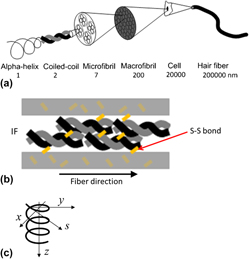Crossref Citations
This article has been cited by the following publications. This list is generated based on data provided by
Crossref.
Alsop, Richard J.
Soomro, Asfia
Zhang, Yuchen
Pieterse, Marc
Fatona, Ayodele
Dej, Kimberly
Rheinstädter, Maikel C.
and
Haverkamp, Richard G.
2016.
Structural Abnormalities in the Hair of a Patient with a Novel Ribosomopathy.
PLOS ONE,
Vol. 11,
Issue. 3,
p.
e0149619.
X. Gu, Grace
Su, Isabelle
Sharma, Shruti
Voros, Jamie L.
Qin, Zhao
and
Buehler, Markus J.
2016.
Three-Dimensional-Printing of Bio-Inspired Composites.
Journal of Biomechanical Engineering,
Vol. 138,
Issue. 2,
Antunes, Egipto
Cruz, Célia F.
Azoia, Nuno G.
and
Cavaco-Paulo, Artur
2016.
Insights on the mechanical behavior of keratin fibrils.
International Journal of Biological Macromolecules,
Vol. 89,
Issue. ,
p.
477.
Soomro, Asfia
Alsop, Richard J.
Negishi, Atsuko
Kreplak, Laurent
Fudge, Douglas
Kuczmarski, Edward R.
Goldman, Robert D.
and
Rheinstädter, Maikel C.
2017.
Giant axonal neuropathy alters the structure of keratin intermediate filaments in human hair.
Journal of The Royal Society Interface,
Vol. 14,
Issue. 129,
p.
20170123.
Fantilli, Alessandro P.
Sicardi, Silvio
and
Dotti, Francesca
2017.
The use of wool as fiber-reinforcement in cement-based mortar.
Construction and Building Materials,
Vol. 139,
Issue. ,
p.
562.
Huang, Wei
Yaraghi, Nicholas A.
Yang, Wen
Velazquez-Olivera, Alexis
Li, Zezhou
Ritchie, Robert O.
Kisailus, David
Stover, Susan M.
and
McKittrick, Joanna
2019.
A natural energy absorbent polymer composite: The equine hoof wall.
Acta Biomaterialia,
Vol. 90,
Issue. ,
p.
267.
Lazarus, Benjamin S.
Chadha, Charul
Velasco-Hogan, Audrey
Barbosa, Josiane D.V.
Jasiuk, Iwona
and
Meyers, Marc A.
2021.
Engineering with keratin: A functional material and a source of bioinspiration.
iScience,
Vol. 24,
Issue. 8,
p.
102798.
Islam, Muhammed Kamrul
Hazell, Paul J.
Escobedo, Juan P.
and
Wang, Hongxu
2021.
Biomimetic armour design strategies for additive manufacturing: A review.
Materials & Design,
Vol. 205,
Issue. ,
p.
109730.
Weiand, Erik
Ewen, James P.
Koenig, Peter H.
Roiter, Yuri
Page, Steven H.
Angioletti-Uberti, Stefano
and
Dini, Daniele
2022.
Coarse-grained molecular models of the surface of hair.
Soft Matter,
Vol. 18,
Issue. 9,
p.
1779.
Islam, Muhammed Kamrul
Wang, Hongxu
Hazell, Paul J.
Kader, Md Abdul
and
Escobedo, Juan P.
2022.
Quasi-static response of horse hoof inspired biomimetic structures.
Materials Today: Proceedings,
Vol. 59,
Issue. ,
p.
1168.
Šindelka, Karel
Kowalski, Adam
Cooke, Michael
Mendoza, César
and
Lísal, Martin
2023.
Interactions of cationic surfactant-fatty alcohol monolayers with natural human hair surface: Insights from dissipative particle dynamics.
Journal of Molecular Liquids,
Vol. 375,
Issue. ,
p.
121385.
Breakspear, S.
Nöcker, B.
and
Popescu, C.
2024.
Chemical bonds and hair behaviour—A review.
International Journal of Cosmetic Science,
Vol. 46,
Issue. 5,
p.
806.
Chen, Nuo
Yang, Xin
Xu, Shucai
and
Song, Jiafeng
2024.
Structural and mechanical characterization of the hoof in Mongolian equids.
Micron,
Vol. 180,
Issue. ,
p.
103609.
Taylor, David
Barton, Ellen
Duffy, Isobel
Enea-Casse, Ramona
Marty, Guillaume
Teeling, Robert
and
Santoprete, Roberto
2024.
The biomechanics of splitting hairs.
Interface Focus,
Vol. 14,
Issue. 3,
Hassas, Najmeh
Khadam, Seyed Soroush Mousavi
Borucka, Justyna
and
Bardzińska-Bonenberg, Teresa
2025.
Unveiling the Secrets of Goat Hair: Structural and Qualitative Insights for Iranian Nomadic Black Tent.
Journal of Natural Fibers,
Vol. 22,
Issue. 1,
Liu, Qingrong
Chen, Yansong
Liu, Qingping
Zhou, Xueli
and
Ren, Luquan
2025.
Unraveling the performance mysteries of bionic triangular heterogeneous suture interfaces.
Materials & Design,
Vol. 260,
Issue. ,
p.
115012.
Dong, Yalin
Yu, Jinlin
Wen, Xian
Sun, Zhaoyang
Duan, Yikun
Wang, Liming
and
Qin, Xiaohong
2025.
High-Efficiency Dry-Jet Wet Spinning of Ultratoughness Regenerated Wool Keratin Fibers.
Nano Letters,
Vol. 25,
Issue. 13,
p.
5078.
Weiand, Erik
Rodriguez-Ropero, Francisco
Roiter, Yuri
Angioletti-Uberti, Stefano
Dini, Daniele
and
Ewen, James P.
2025.
Understanding and controlling the friction of human hair.
Advances in Colloid and Interface Science,
Vol. 345,
Issue. ,
p.
103580.
Freigassner, Julia
van Nieuwenhoven, Richard W.
and
Gebeshuber, Ille C.
2025.
From nanostructure to function: hierarchical functional structures in chitin and keratin.
Zeitschrift für Physikalische Chemie,
Vol. 239,
Issue. 9,
p.
1443.
Plowman, Jeffrey E.
Grosvenor, Anita J.
Deb‐Choudhury, Santanu
Bell, Fraser
Roberts, Julie
and
Clerens, Stefan
2025.
Key locations of oxidative damage in human hair keratins after heat and ultraviolet light exposure.
International Journal of Cosmetic Science,
Vol. 47,
Issue. 6,
p.
1104.


